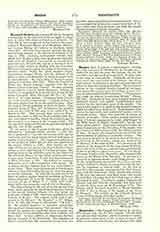

Hospice (Lat. hospitium, a guest-house).—During the early centuries of Christianity the hospice was a shelter for the sick, the poor, the orphans, the old, the travelers, and the needy of every kind. It dates back to the reign of Constantine. Originally all hospices were under the supervision of the bishops, who designated priests to administer the spiritual and temporal affairs of these charitable institutions. The fourteenth statute of the so-called Fourth Council of Carthage, held about 436, enjoins upon the bishops to have hospices in connection with their churches: “Ut episcopus non longe ab ecclesia hospitiolum habeat” (Mansi, III, 952). In course of time these hospices of general character ceased, and special establishments were erected for the particular needs of the people. The term hospice began to be applied only to institutions in which travellers were harbored. Such hospices were erected in impassable and uninhabited regions and on mountain passes. They were generally in charge of hermits or monks. Their number greatly increased when it became customary to make pilgrimages to the Holy Land, to Rome, Compostela, Amalfi, and other sacred places. They were supported either by pious foundations or the liberality of the people, and gave food and shelter gratuitously, for a limited period of time. In many cities hospices were erected for the entertainment of pilgrims of particular nations. The most famous hospice in the world is that of the Great St. Bernard in Switzerland, which was founded by St. Bernard of Menthon in 962. It is situated on the summit of the mountain of the same name, 8110 feet above the level of the sea, and harbors gratuitously 20,000 to 25,000 travellers every year. It is in charge of Canons Regular of St. Augustine, who are generally known as the Monks of St. Bernard. At present it is occupied by eighteen monks, eight being priests. On all the neighboring mountains they have recently erected small huts, which are connected with the hospice by telephone or electric bells. At the risk of their lives these monks, accompanied by their famous dogs, tour the mountains, which during nine months of the year are covered with deep snow, and search for travellers who may have lost their way or otherwise stand in need. Two canons regular, Contard and Glassey, together with six attendants, lost their lives on one of these tours on November 19, 1874. The hospice which Napoleon founded on Mount Simplon in 1805 is also in charge of the monks of the Great St. Bernard. The hospice on the Little St. Bernard is since 1752 in charge of Italian monks.
MICHAEL OTT

